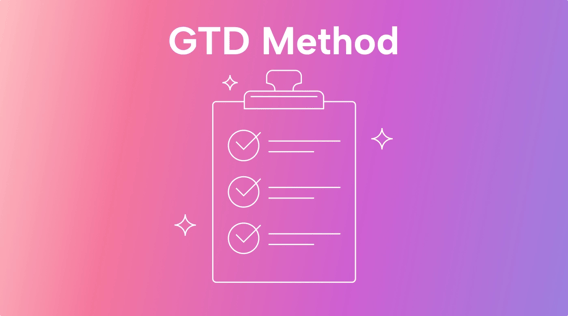Are you stuck in a cycle of reacting to crises as they arise? Do you feel doomed to play catch-up for the rest of your career?
Then it’s time for you to look into the powerful Getting Things Done (GTD) productivity methodology.
GTD helps you take your disorganized thoughts and ideas and structure them into meaningful, sustainable actions. It offers a structured protocol for managing your racing thoughts and the many hats you wear. With just five steps and a weekly review, you’ll feel like a whole new person as you learn to tackle your to-do list with strategy and intention.
What is GTD?
GTD is a practical and thorough productivity method created by productivity specialist and author David Allen. It’s a simple process done frequently to help keep your head clutter-free and your tasks organized.
The GTD method has five steps: Capture, Clarify, Organize, Reflect, and Engage.
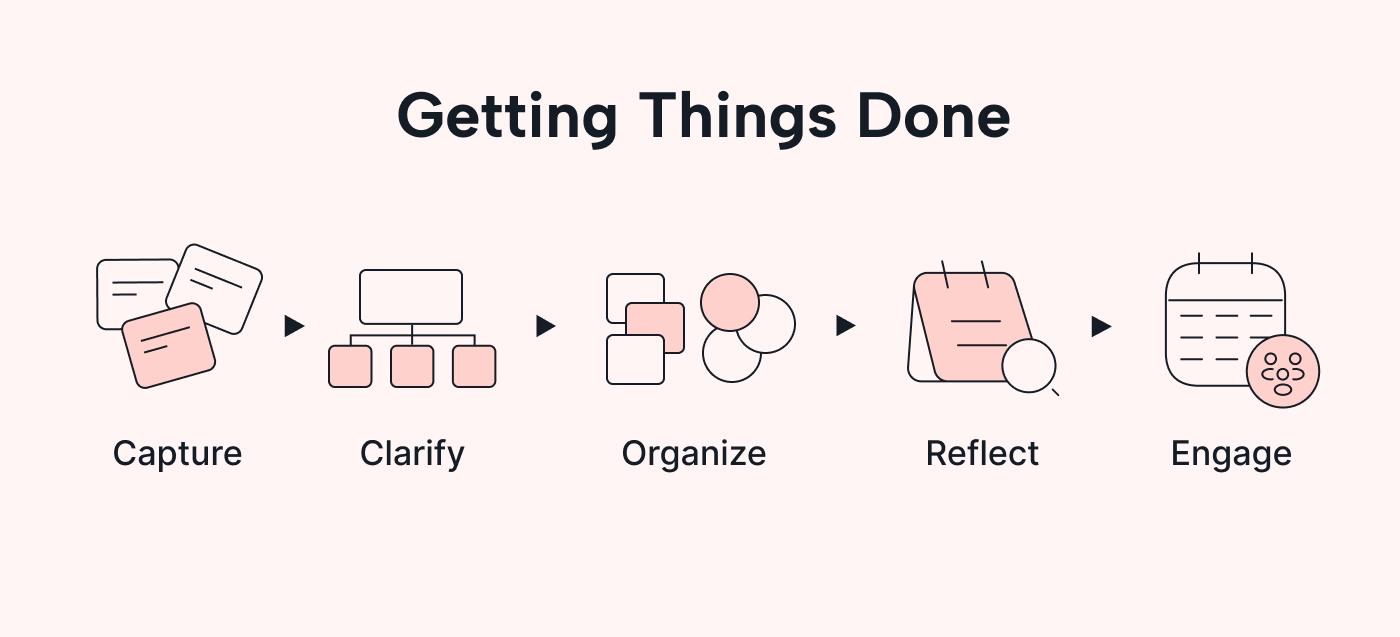 |
In his book, Getting Things Done: The Art of Stress-Free Productivity, David Allen says, “The key to getting things done is defining what ‘done’ means, what ‘doing’ looks like, and where it happens."
By working through the five GTD steps, you can take control of your busy schedule and chaotic thoughts to bring about lasting productivity and sustainable calmness.
Who should use the GTD method?
The GTD method works best for people who:
- Are often overwhelmed by their responsibilities
- Frequently forget tasks or details
- Find it easy to start tasks but struggle to complete them
- Juggle multiple projects or responsibilities at the same time
- Thrive on structure but haven’t found a system that works for them
- Tend to over-prioritize urgent tasks and neglect tasks with flexible deadlines
How does the GTD method work?
There’s no shortage of anecdotal evidence that GTD works. But how exactly does it help you get more done?
Essentially, it goes beyond simply showing you how to get organized. GTD uses systems that make it easier for you to stay organized. It does this in three main ways:
Removing indecision
According to a study on indecisiveness in business, indecision harms a business’s competitive advantage, risks the sustainability of its success, and leads to a loss of revenue and resources.
In other words, indecision is a productivity killer.
GTD tackles indecision by establishing your “next step” ahead of time. You always know what you should be working on next because you planned ahead. This allows you to act decisively and keeps your momentum high.
Related: Why Am I So Indecisive? 10 Ways to Be More Decisive — and Productive
Reducing cognitive load
Your cognitive load is the amount of information your brain’s working memory can process at a given moment.
Your brain prioritizes thinking about interrupted or unfinished tasks. This means that a fleeting thought, plan, or idea can quickly use up some of your valuable working memory.
This phenomenon, known as the Zeigarnik effect, makes it difficult to concentrate fully on a task when you know you have several other thoughts or tasks you haven’t yet dealt with.
GTD gives you a method for recording and later addressing any thoughts you can’t deal with immediately. It frees up your working memory and reduces the cognitive load you carry throughout the day.
Externalizing mental clutter
One of GTD’s key principles is that your brain is not optimized to store information but to process it. Trying to remember everything without writing it down wastes your brain’s cognitive power.
 |
Externalizing your thoughts means collecting them in a physical or digital palace rather than using up your mental space and energy trying to remember them.
In his book The Organized Mind, neuroscientist Daniel Levitin says that externalizing information improves your ability to do knowledge work, like creating, interpreting, or applying the information you’re reading.
5 steps to GTD
Although GTD is backed by years of complicated research, the magic is in its simplicity. By regularly completing the following five simple steps, you can enjoy sustainable productivity that feels natural:
1. Capture
The “Capture” step is when you collect everything that grabs your attention and store it in a consistent external system. We recommend collecting your thoughts in one place so they can act as a source of truth for the next four steps in the GTD process.
You can choose a physical or digital system to collect your thoughts and tasks. Both methods have their pros and cons, as noted in a recent study on pen and paper vs computerized note-taking. Let’s take a look at them:
Benefits of making notes on paper:
- Notes can be personalized with doodles, impromptu mind maps, or underlining.
- Physical note-taking has been associated with improved information recall (which isn’t important for GTD since the whole point is to remember things externally!).
Benefits of using digital note-taking platforms:
- Typing is quicker than writing by hand.
- Points are easy to organize and rearrange.
- Notes are accessible from multiple devices.
In GTD, capturing your thoughts goes beyond creating a task list. Your goal is to be definite and clear as you curate your thoughts, tasks, and ideas. Including this extra layer of detail turns a regular list of tasks from something overwhelming into an actionable tool.
For example, instead of saying, “Improve process documentation for the sales team,” you’d say, “Revise our internal process doc based on notes from Friday’s meeting with Cal.” If you’re using a digital system for capturing, you could also link to any resources, such as the notes from Friday’s meeting.
Tips for capturing:
- Use a trigger list. This is a list of questions or thought prompts that can help jog your memory while you’re capturing. It makes sure you don’t miss any areas of your life when compiling your initial list.
You could divide your trigger list into categories like Personal, Professional, and Home, with subcategories to jog your memory, like Projects, Meetings, Deadlines, and Admin, within the Professional category, for instance.
- Find an on-the-go capturing system. You won’t always have access to your ideal note-capturing system, especially if you’re on the go. Find a quick and simple system to capture thoughts and reminders when you’re in the middle of an important meeting or standing in line at the grocery store, such as a mobile app that lets you create tasks either by typing or with voice commands.
2. Clarify
Now that you have a comprehensive list of your tasks, it’s time to get specific about what done looks like and what doing entails for each item.
For every task on your list, outline:
- Your “done”: This is the task’s ideal outcome or result. Be specific and detailed as you describe exactly what a successful finish looks like.
- Your “doing”: These are the action steps you need to take to reach the end goal you’ve just described. Break the project or task down into smaller, more actionable steps. Make the steps as small as you need to for the project to feel manageable.
Once you’ve clarified each item on your list, divide the tasks into actionable and non-actionable items.
- Actionable tasks are tasks you can do, delegate, or defer.
- Non-actionable tasks are tasks you can delete, incubate, or reference later.
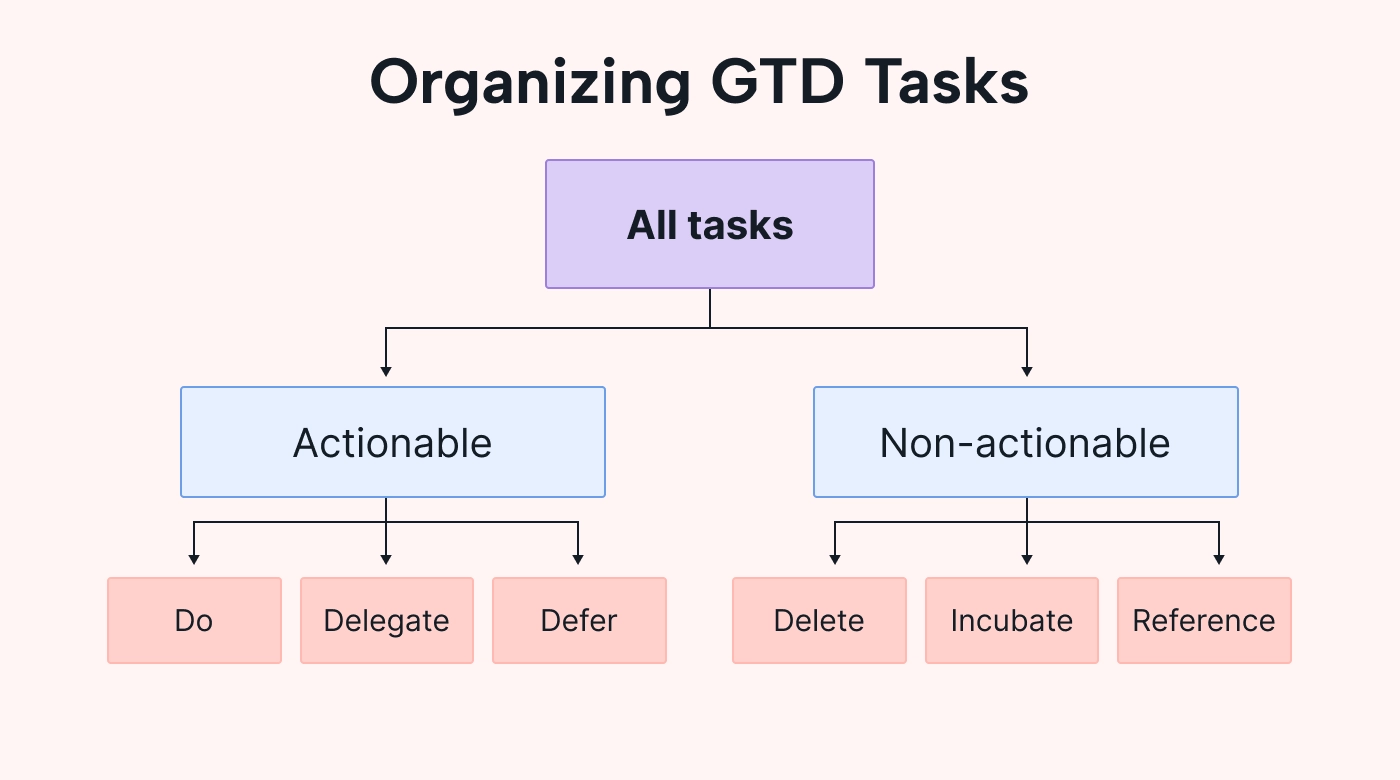 |
Tips for clarifying:
- Don’t over-plan. Although GTD calls for a high level of detail, you don’t want to waste time planning in so much detail that the task becomes overwhelming. Lots of detail might be important for complex tasks, but you can keep the steps for administrative tasks simple.
3. Organize
In this step, you’ll organize your main list into different categories. Allen outlines several categories in his book, with the most popular being the following:
- Calendar list: This contains anything that’s time-sensitive, such as appointments, day-specific activities, and event-specific info.
- Projects lists: These contain all tasks related to the specific project.
- References list: This includes anything that you want to refer back to in the future but doesn’t require any action.
- Next actions list: This contains all steps and future actions you can do to contribute to large goals and projects.
- Waiting for/on hold list: This contains all tasks you can’t do anything with until an external factor shifts.
- Someday/maybe list: This holds your ideas and tasks that you’d like to work on but can’t devote time to yet.
Tips for organizing:
- Start with what you know, and organize the easy-to-categorize items first. This gives you a better feel for where the remaining tasks should go.
- Don’t be afraid to put tasks on hold since you’ll be reviewing them in a week’s time. There’s no rush for things that you aren’t sure of yet. You can add soft deadlines to any ideas you don’t want to put off indefinitely.
4. Reflect
During the reflection stage, you’ll assess the organizing you’ve done so far and decide how to proceed with your planning and time management.
Allen outlines two types of reviews:
- Daily reviews are shorter and performed at the beginning or end of the day to determine what needs to be done today or tomorrow, respectively. This regular review is an essential part of daily planning because it defines your goals for each day.
- Weekly reviews are longer, often taking one to two hours. You’ll dedicate this block of time to capturing, clarifying, and organizing all upcoming projects, ideas, and tasks. You’ll also review all project plans, your next actions list, your waiting for/on hold list, and your someday/maybe list. Despite being the most difficult part of GTD to perform consistently, the weekly review is a crucial step if you want the GTD system to remain effective over time.
 |
Tip for reflecting:
- Build reviews into your routine so you don’t neglect them. Schedule them for days and times of day when it feels most natural to plan, whether that’s at the start of the week or the end.
5. Engage
You’re almost there! This step is all about choosing what to do and when.
David Allen describes three models to help you schedule your tasks and choose what to work on:
1. Choosing in the moment
To choose what task to work on next in the moment, look at the context and priority of different tasks and weigh them against your energy levels and available time. This method takes a more reactive approach to planning, but it can work well if you’re a decisive person who problem-solves on the spot.
2. Identifying daily work
In this model, you handle tasks in three ways. At any moment, you can:
- Work on predefined work that you scheduled for now ahead of time.
- Work on tasks as they show up and take a reactive approach to any unexpected tasks.
- Follow the 2-minute rule by immediately completing any tasks that take less than two minutes to complete.
3. Reviewing your work
The final model involves looking at your work from different angles, or altitudes, as Allen calls them, to manage your flow of work effectively. This model aims to keep all tasks in context, constantly linking back to the bigger picture.
The altitudes are as follows:
- Horizon 5: Your principles and values
- Horizon 4: Your vision of your organization and understanding of what has to happen for that vision to be achieved
- Horizon 3: Your goals and objectives
- Horizon 2: Your responsibilities and areas where you’re held accountable
- Horizon 1: Your current projects
- Ground: All current actions you perform daily
Tips for engaging:
- Know your immovables that you have no control over, such as team meetings, client appointments, and time-sensitive personal commitments, so that you can plan tasks around these things.
- Use technology like Motion’s Task Manager to organize your schedule and arrange your tasks for you.
GTD with Motion
Using a digital productivity tool like Motion can streamline the GTD process and supercharge its benefits.
Unlike to-do list apps, which tend to overcomplicate your task management process without actually saving any time, Motion takes care of the how behind getting things done. It prioritizes your tasks automatically, so you don’t have to spend mental energy figuring out how to organize your day.
Motion’s task management tool and intelligent calendar work together to create the perfect schedule in seconds. If you’re looking to simplify the GTD method, Motion can help in the following ways:
- Automates repeating tasks to simplify your daily and weekly planning
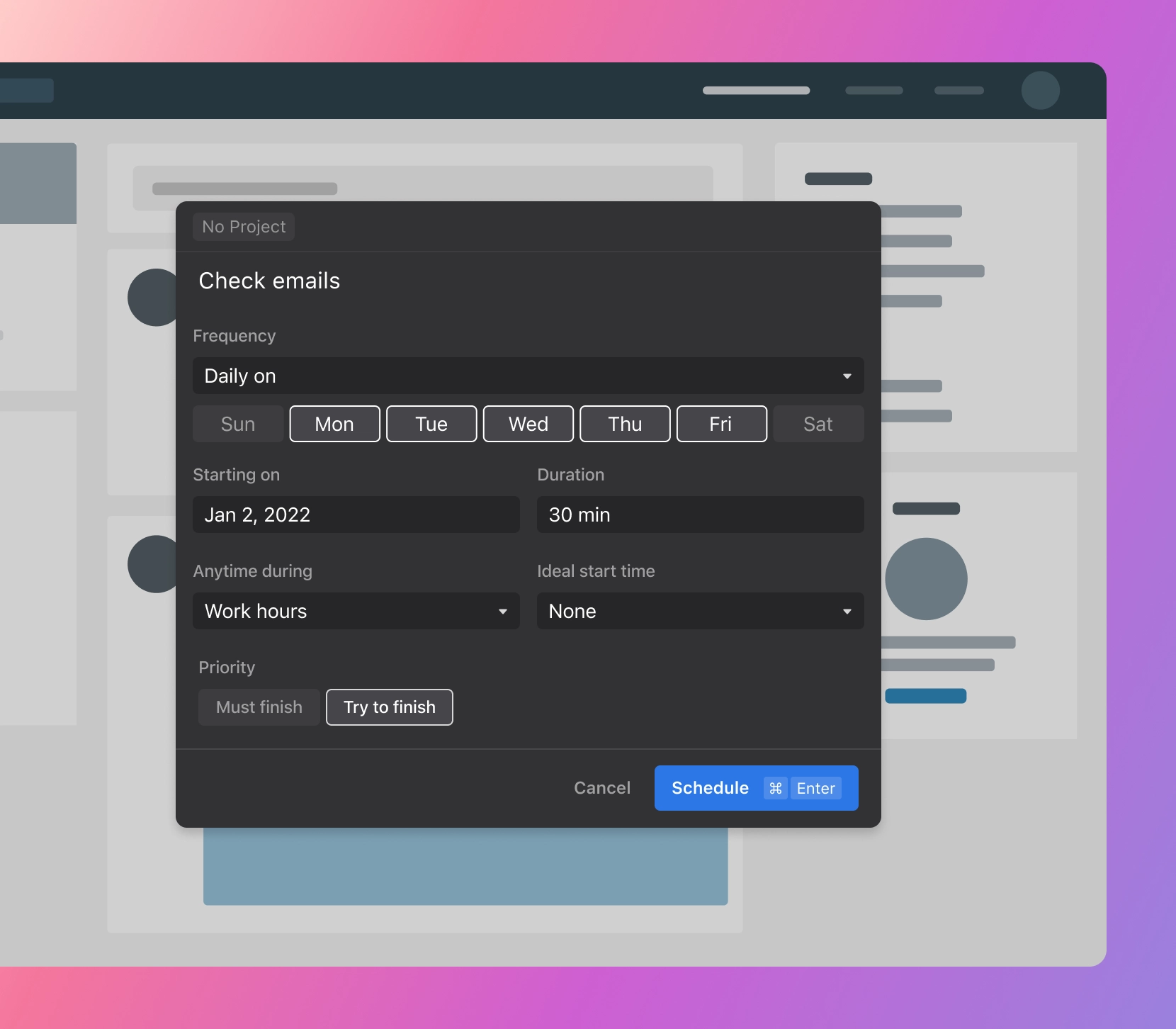
- Protects your weekly review time by marking you as “busy” for the duration of the event, preventing interruptions while you plan and organize your week
- Auto-schedules tasks according to their importance and deadline, finding the optimal layout of tasks around your existing schedule (essentially, it does Step 4 of GTD for you!)
- Alerts you of approaching deadlines to provide another layer of protection against forgetfulness, acting as an external hub for important dates and appointments.
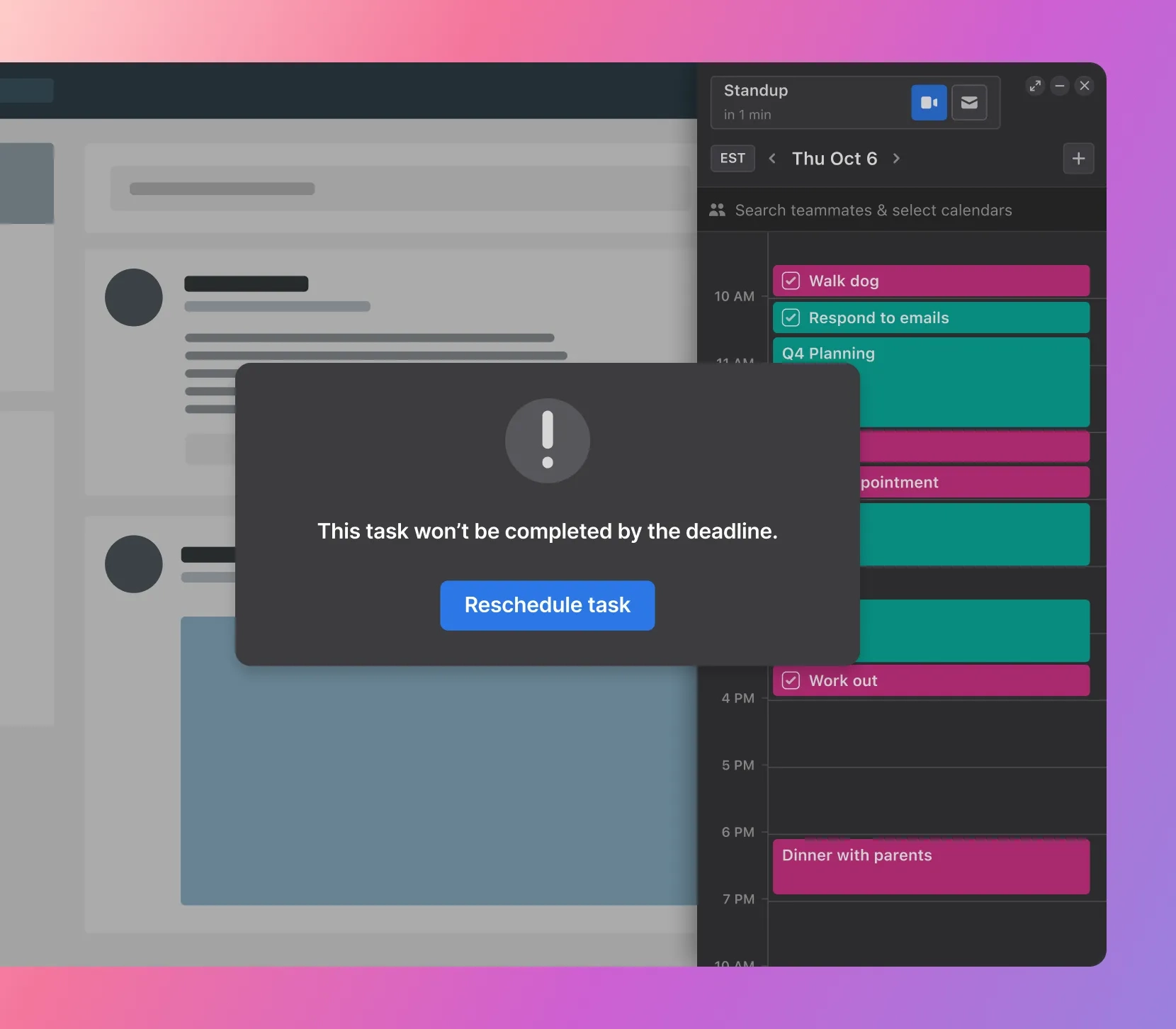 |
Let Motion help you get things done
The GTD methodology has helped countless people find order and structure in the midst of professional chaos. This simple five-step process gives your thoughts a safe place to land and tells you exactly what to do with them once they’ve stopped knocking around in your brain.
If you’re interested in trying out the GTD method, why not use technology to make it easier?
Motion is a powerful productivity tool that works hand-in-hand with GTD by simplifying your planning and auto-scheduling your tasks for you.
Ready for stress-free productivity? Try Motion for free today.

Haylee is a versatile writer with ten years of experience. With a background in marketing and writing for large SaaS companies, Haylee brings her passion for the written word to diverse projects ranging from blog posts and ebooks to direct marketing campaigns.
